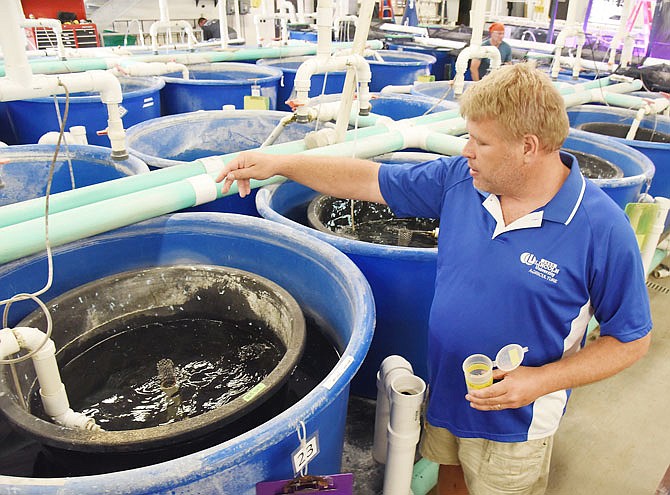There's something fishy going on at the Lincoln University aquaculture research facility.
Students and faculty are in the process of feed training black bass so they can cultivate large numbers of the fish for human consumption.
Jim Wetzel, aquaculture program coordinator at LU, is overseeing the black bass project.
In the aquaculture research facility at the George Washington Carver Farm are rows of small tanks, many containing large amounts of small, young black bass.
Wetzel said 500-1,000 of these little fish may be in one tank at a time. Looking in, it can be hard to believe there are that many.
Wetzel and the others at the facility are feed training the fish - teaching them to eat man-produced food pellets instead of their natural food. If fish eat the pellets, the facility can produce a lot more pounds of fish in a small area.
"You can only raise so many fish (without pellets)," Wetzel said. "Part of the reason is that food becomes exhausted, but secondly they're prone to cannibalizing. There's a few that start eating their siblings."
In order to raise more and larger fish, they need to eat pellets.
Feed training is a multi-step process. It starts when the fish are born then brought into the facility. They let the fish adjust to the change in environment from the pond to the tanks, then the fish are measured for length and divided into groups of similar sizes.
Then the training begins.
In order to train the bass, which are used to eating living things, to eat the pellets, they start by feeding them krill - small crustaceans with a pleasant smell and taste. The krill aren't alive, but the fish want to eat them because of the good flavor.
The first few feeds of krill excite the fish and train them to expect good food when something hits the surface of the water.
"They associate us - and something hitting the water - with something good to eat," Wetzel said.
For the first three or four days, the fish get pure krill. Then they get a mixture of 75 percent krill and 25 percent pellets, by weight. After another few days, the mixture becomes half and half, then switches to 25 percent krill and 75 percent pellets.
After a couple weeks, the fish are eating straight pellets, which are made from fish meal, soybean meal and corn.
Feed training the fish isn't an easy job. During the feed-training stages, they feed the fish every two hours, from 7 a.m-7 p.m. seven days a week, Wetzel said. The tanks also have to be cleaned. So for two months, Wetzel and his crew get no days off.
When asked if the process could be automated to cut down on labor, Wetzel said it is possible, but he prefers it this way.
"With the actual feed-training part, the best way for me has been actually developing a rapport with the fish," Wetzel said. "They're getting used to you, because later on, you want that. You want them to splash when you approach the pond and be excited by you."
Once the fish are eating solely pellets, some are weeded out of the groups. If they aren't eating the pellets, they don't survive. Wetzel called them "non-feeders." Then the fish are graded for length again.
But getting the fish feed trained isn't the endgame at the facility. The real goal is cultivating a large amount of black, or large-mouth, bass as food fish and teaching other local farmers to feed train their own fish.
Wetzel said an issue for Missouri farmers interested in having feed-trained fish is that they often come from Arkansas, and sometimes those fish aren't compatible with the Missouri ecosystem, and they die.
Once the fish are feed trained, they are moved outside to a pond and fed larger pellets as they grow. In one of the ponds at the location off of Bald Hill Road, about 1,200 bass from last year's crop are still swimming.
That large amount of fish is one of the reasons feeding with pellets is important.
"There's so many bass in this pond, there's no way that you would have enough natural food in this pond to feed them," Wetzel said as he threw a scoop of food pellets into the pond. After a moment, the water started rippling as the bass came up to get the food. "They are eating something that a wild bass would simply ignore."
They only have one pond of fish from last year, but Wetzel hopes they will have multiple from this summer's crop.
When it comes time to harvest fish, Wetzel said would like to have close to 2,000 pounds of fish to sell, although predators like otters may make a dip in that.
Wetzel hopes to use the project to teach other farmers how to feed train and raise their own bass.
"The problem we've got, when it comes to raising food-fish, is none of the farmers that I know of know how to feed train fish," Wetzel said. "None of them do, and Missouri is one of the bigger states when it comes to fish production. Our guys don't know how to feed train fish."
To help Missouri farmers, they've been offering to demonstrate the process, which they've done a few times to farmers and high school students in the area.
While they've been working on the project for about 10 years, they're finally at a point where they can sell the fish at the Lincoln University Farmers Market, and they hope to sell in other local markets.

